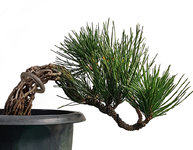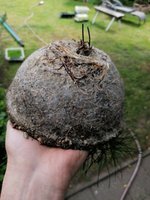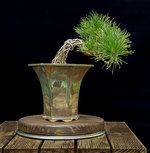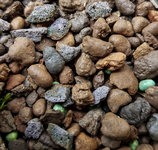Clicio
Masterpiece
Three weeks ago, when buds were starting to swell around here, I noticed that one of the JBP (a neagari in a tall pot) was not draining very well. As it had been repotted in the spring of 2019 in very draining soil, I decided to pull it off from the pot to check the issue.
To my big surprise the whole rootball was surrounded by the whitish fine web of mychorrizea, but the bottom was completely white.
I sawed off a slice of the bottom, replaced the plant into the pot, and the issue was gone.
I didn't post this experience at the time because I wasn't certain that this was really possible, mychorrizea blocking out the drainage of the pot, but reading Michael Hagedorn's excellent book "Bonsai Heresy", he mentions it as a constant issue with his pines.
Unfortunately it didn't occur to me to take a picture of the rootball, but below is an old picture of the pine in its training plastic pot. Tomorrow I will try to take a picture of in in it's new pot, if it matters.
To my big surprise the whole rootball was surrounded by the whitish fine web of mychorrizea, but the bottom was completely white.
I sawed off a slice of the bottom, replaced the plant into the pot, and the issue was gone.
I didn't post this experience at the time because I wasn't certain that this was really possible, mychorrizea blocking out the drainage of the pot, but reading Michael Hagedorn's excellent book "Bonsai Heresy", he mentions it as a constant issue with his pines.
Unfortunately it didn't occur to me to take a picture of the rootball, but below is an old picture of the pine in its training plastic pot. Tomorrow I will try to take a picture of in in it's new pot, if it matters.




